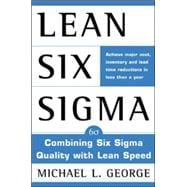
Note: Supplemental materials are not guaranteed with Rental or Used book purchases.
Purchase Benefits
Looking to rent a book? Rent Lean Six Sigma Combining Six Sigma Quality with Lean Production Speed [ISBN: 9780071385213] for the semester, quarter, and short term or search our site for other textbooks by George, Michael. Renting a textbook can save you up to 90% from the cost of buying.
Michael L. George is founder and president of George Group which, with over 70 consultants, is the largest Six Sigma consulting practice in the United States. The firm also provides its clients with a wealth of experience in Lean Methods, Supply Chain Acceleration, and other essential business strategies.
| Preface | ix | ||||
| Part One. The Lean Six Sigma Value Proposition | 1 | (78) | |||
|
3 | (12) | |||
|
4 | (4) | |||
|
8 | (1) | |||
|
9 | (4) | |||
|
13 | (1) | |||
|
13 | (1) | |||
|
14 | (1) | |||
|
15 | (18) | |||
|
17 | (6) | |||
|
23 | (1) | |||
|
24 | (7) | |||
|
31 | (1) | |||
|
32 | (1) | |||
|
32 | (1) | |||
|
32 | (1) | |||
|
33 | (28) | |||
|
34 | (1) | |||
|
35 | (1) | |||
|
36 | (13) | |||
|
49 | (2) | |||
|
51 | (1) | |||
|
51 | (5) | |||
|
56 | (3) | |||
|
59 | (1) | |||
|
59 | (1) | |||
|
60 | (1) | |||
|
60 | (1) | |||
|
61 | (18) | |||
|
62 | (9) | |||
|
71 | (5) | |||
|
76 | (3) | |||
| Part Two. The Lean Six Sigma Implementation Process | 79 | (156) | |||
|
85 | (8) | |||
|
87 | (1) | |||
|
87 | (5) | |||
|
92 | (1) | |||
|
93 | (24) | |||
|
94 | (2) | |||
|
96 | (1) | |||
|
96 | (2) | |||
|
98 | (12) | |||
|
110 | (3) | |||
|
113 | (2) | |||
|
115 | (1) | |||
|
116 | (1) | |||
|
117 | (8) | |||
|
118 | (1) | |||
|
119 | (1) | |||
|
120 | (1) | |||
|
120 | (1) | |||
|
120 | (2) | |||
|
122 | (1) | |||
|
122 | (1) | |||
|
123 | (1) | |||
|
123 | (2) | |||
|
125 | (32) | |||
|
126 | (1) | |||
|
127 | (2) | |||
|
129 | (1) | |||
|
130 | (1) | |||
|
131 | (1) | |||
|
132 | (12) | |||
|
144 | (2) | |||
|
146 | (2) | |||
|
148 | (5) | |||
|
153 | (2) | |||
|
155 | (1) | |||
|
156 | (1) | |||
|
157 | (10) | |||
|
158 | (1) | |||
|
159 | (3) | |||
|
162 | (1) | |||
|
163 | (2) | |||
|
165 | (2) | |||
|
167 | (15) | |||
|
168 | (2) | |||
|
170 | (3) | |||
|
173 | (4) | |||
|
177 | (1) | |||
|
178 | (3) | |||
|
181 | (1) | |||
|
182 | (44) | |||
|
183 | (2) | |||
|
185 | (14) | |||
|
199 | (4) | |||
|
203 | (19) | |||
|
222 | (2) | |||
|
224 | (2) | |||
|
226 | (9) | |||
|
228 | (4) | |||
|
232 | (1) | |||
|
232 | (2) | |||
|
234 | (1) | |||
| Part Three. Leveraging Lean Six Sigma | 235 | (74) | |||
|
237 | (33) | |||
|
238 | (19) | |||
|
257 | (9) | |||
|
266 | (4) | |||
|
270 | (20) | |||
|
271 | (2) | |||
|
273 | (5) | |||
|
278 | (2) | |||
|
280 | (1) | |||
|
281 | (7) | |||
|
288 | (2) | |||
|
290 | (19) | |||
|
292 | (4) | |||
|
296 | (7) | |||
|
303 | (4) | |||
|
307 | (2) | |||
| Index | 309 |
The New copy of this book will include any supplemental materials advertised. Please check the title of the book to determine if it should include any access cards, study guides, lab manuals, CDs, etc.
The Used, Rental and eBook copies of this book are not guaranteed to include any supplemental materials. Typically, only the book itself is included. This is true even if the title states it includes any access cards, study guides, lab manuals, CDs, etc.